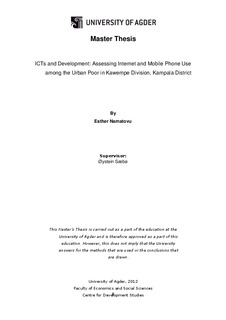| dc.contributor.author | Namatovu, Esther | |
| dc.date.accessioned | 2012-11-22T09:12:57Z | |
| dc.date.available | 2012-11-22T09:12:57Z | |
| dc.date.issued | 2012 | |
| dc.identifier.uri | http://hdl.handle.net/11250/135229 | |
| dc.description | Master thesis in development management- University of Agder, 2012 | no_NO |
| dc.description.abstract | This study set out to understand and assess internet and mobile phone uses among the urban poor in Kawempe division in Kampala district, Uganda. As the internet and mobile phones are rapidly diffusing through communities with more people having access to them, it is important to understand what people are actually doing with their access. There has been so much optimism and scepticism among scholars around the potential of ICTs in facilitating both economic and social development. This study thus seeks to build on the knowledge of how ordinary internet and mobile phone usage may influence social and economic development. Having an understanding of internet and mobile phone usage is important to this study because it helps to give an insight into the potential economic and social development impacts of these two ICTs.
The study is carried out as a case study in the context of Kawempe and is conducted through a triangulation of qualitative methods. It is also examined through the Diffusion of Innovations Theory (DoI) and the Capability Approach. The Perceived Characteristics of Innovations (PCIs) in the DoI theory explained motivations behind internet and mobile phone adoption and access which also directly helped to understand usage patterns but six out of the eight PCIs showed significant influence. The CA then helped to understand the impact of these uses on both social and economic development through assessing capability enhancement through the various uses directed towards the two aspects of development.
Internet access was found to be so low due to high illiteracy and costs. There is negligible individual ownership of the internet and the majority of respondents use internet cafés. Internet use is mostly directed towards communication with family and friends with very low use in economic, health and education related issues. On the other hand, mobile phone access was found to be very high and with very high individual ownership of handsets. This is mainly attributed to the low cost and ease of use of the mobile phone. Mobile phone uses are also mostly directed towards communication with family and friends but there is a substantial integration of mobile phones in people’s economic activities but with minimal use in education and health related issues. | no_NO |
| dc.language.iso | eng | no_NO |
| dc.publisher | Universitetet i Agder; University of Agder | no_NO |
| dc.subject.classification | UT 503 | |
| dc.title | ICTs and development: assessing internet and mobile phone use among the urban poor in Kawempe division, Kampala district | no_NO |
| dc.type | Master thesis | no_NO |
| dc.subject.nsi | VDP::Social science: 200::Social anthropology: 250 | no_NO |
| dc.source.pagenumber | 118 s. | no_NO |
